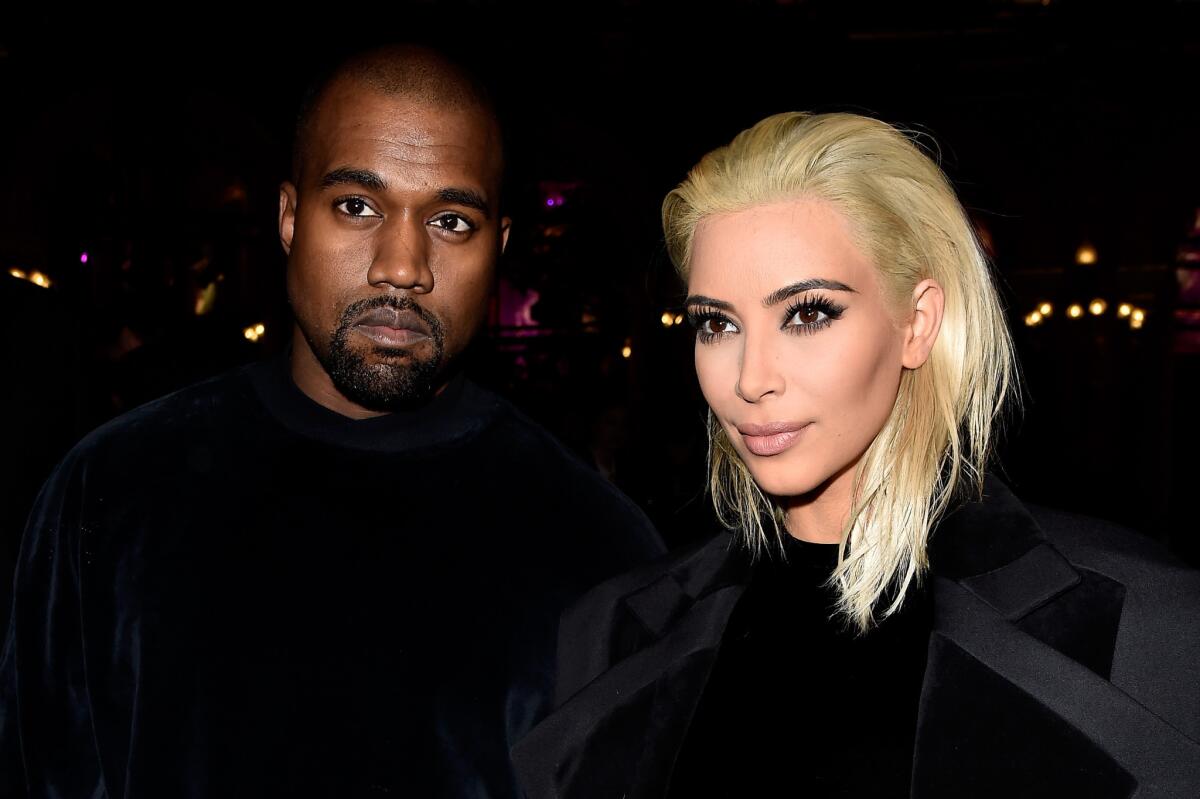Commentary: ‘Celebreality’ was already in decline. The Kardashians just put it out of its misery
When “Keeping Up With The Kardashians” premiered 13 years ago, the Kardashians looked nothing like they do now. Neither did TV.
In 2007, cable was ascendant, siphoning millions of viewers away from the broadcast networks. Reality TV — specifically the subgenre of “celebreality” shows about the marginally famous — was thriving on channels like VH1, MTV and E!, where the Kardashians set up shop.
The show was formulaic rather than groundbreaking, a clear derivative of the many other unscripted sitcoms starring C-listers that dotted basic cable at the time. There was little to suggest it would endure for 20 seasons, turning the Kardashians into one of the most powerful dynasties in Hollywood and reshaping the nature of contemporary celebrity along the way.
But “KUWTK” arrived at just the right time, as platforms like Twitter and Instagram gave celebrities a new way to broadcast their lives to fans. Unabashedly attention-hungry, the Kardashians cannily stoked interest in their personal dramas — the short-lived marriages, pregnancies, cheating scandals and countless cosmetic enhancements — even when the cameras weren’t rolling. “Influencers” before the term existed, they were willing to shill just about anything: dubious weight-loss pills, exploitative debit cards and especially themselves.
“Keeping Up With the Kardashians” stars Kim Kardashian, Kris Jenner and their family announced Tuesday that their E! reality series will end in 2021.

Yet the show itself has long since become an afterthought to the relentless saga of the Kardashian-Jenner clan playing out in real time on social media, where the family has an audience of billions. Baby sister Kylie Jenner has become the family’s undisputed social media champ, with 190 million Instagram followers — beating big sister Kim (and Beyoncé).
In contrast, the show, which once generated up to 3 or 4 million live viewers a week, now draws fewer than 1 million. And even though they were paid handsomely to appear — nearly $100 million for three seasons, according to Variety — the Kardashians’ various side projects, including skincare lines and role-playing video games, are every bit as lucrative but far less intrusive.
So when Kim announced last week — via Instagram, naturally — that “KUWTK,” which returns from a five-month hiatus on Thursday, would come to an end next year, the news was perhaps not as shocking as it should have been: When you already live your life in the public eye, a reality show is superfluous.
The end of “Keeping Up With the Kardashians” is unlikely to loosen the family’s grip on pop culture. But it highlights a difficulty plaguing other long-running reality shows — including Bravo’s “Real Housewives” franchise — which rely on storylines that are familiar to viewers long before episodes make it to air, thanks to social media and tabloid coverage.
It comes as Paris Hilton, the “celebutante” whose sex tape infamy-turned-reality TV fame set the blueprint for Kim Kardashian, attempts to recast her image with a documentary, “This Is Paris.”
And from the beginning, the Kardashian family’s onscreen hijinks were often overshadowed by off-camera scandal: six months before “KUWTK” premiered on E!, Kim Kardashian became an overnight star thanks to a widely circulated sex tape of her own. (The pilot episode follows a nervous Kim as she prepares to discuss the tape on “The Tyra Banks Show” ). Though she has long denied any involvement in its release, the tape certainly stoked public curiosity about Kim, an otherwise little-known stylist who supposedly planted blind items about herself in the tabloids and sometimes tagged along with Hilton, her bestie and star of “The Simple Life,” on the red carpet.
With executive producers including “American Idol” host Ryan Seacrest and “The Real World” co-creator Jonathan Murray, “KUWTK” was a product of the reality TV establishment. And it followed a formula that had worked for other shows.
If “Newlyweds: Nick and Jessica” was “I Love Lucy” but with teen pop stars, and “The Osbournes” was “The Adventures of Ozzie and Harriet,” except Ozzie was a heavy metal singer who once bit the head off a bat rather than an All-American Dad, “Keeping up With the Kardashians” was, as Kim says in the pilot, “a modern-day ‘Brady Bunch’ with a kick” — a domestic sitcom about a big, blended family full of bickering siblings and frequently exasperated parents. These inexpensive hits were at once contemporary and a throwback to the early days of the genre, when actors often starred opposite their real-life spouses and children.
Kim was, if not the most accomplished, then certainly the most notorious member of the family, and early promotional materials positioned her as the series’ protagonist. But even then she was known mostly for her proximity to other, more renowned people — she was the daughter of the guy who defended O.J. Simpson, the stepsister of the guy from “The Hills” and, most of all, the girl from the sex tape with Brandy’s brother.
Despite their increasingly extravagant lifestyle, the Kardashians’ dynamics were relatable to anyone who’d grown up in a raucous household with numerous siblings, and the family members eagerly fell into their assigned roles. Kim was the princess, Khloe the bitch, Kourtney the mature one. When Kim wept about losing a $75,000 diamond earring in the ocean in Bora Bora, Kourtney spoke for viewers by reminding her sister, “There are people that are dying.” Moms everywhere felt Kris’ pain when she had to clean up the poop left by Kendall’s dog while the teen supermodel was away on assignment.
The sheer number of Kardashians and Jenners, combined with their various romantic partners, ever-expanding brood of children and menagerie of neglected pets, made them an instant franchise — not so much family members as characters in a shared reality TV universe. E! spun off “KUWKT” with Dick Wolf-ian zeal, creating a slew of spinoffs — many of them forgettable — including “Life of Kylie,” “Dash Dolls,” “Rob & Chyna,” “Khloe & Lamar” and “Flip It Like Disick.”
Even though it followed many similar shows to the airwaves, “KUWTK” ultimately benefited by premiering during a cultural shift. It arrived just as the public’s interest in Hilton, freshly out of jail, was waning, meaning Kim could step into the It Girl void. The first iPhone had just been introduced, Twitter was in its infancy and Instagram was just around the corner, allowing the show to build an audience of millions as social media use skyrocketed.
Pay cable subscriptions peaked in 2010, the year before Kim’s wedding to NBA player Kris Humphries was broadcast in a two-part special on E!.
November 2014 arguably marked a turning point in the story of the Kardashians: That’s when Kim appeared, naked and glistening, on the cover of Paper Magazine. The picture was credited with “breaking the internet,” but what it really did was show how the Kardashians’ fame had far eclipsed their their modest little reality show.
As it went on, “KUWTK” became a meta text about the Kardashians’ fame. Tabloid rumors, lurking paparazzi and sibling disputes over who was or wasn’t willing to film the show became dramatic plot points — and watching it became a weird form of time travel to the recent past.
Devoted Kardashiologists couldn’t help but parse the differences between the show’s carefully edited narrative and version of events that had played out dramatically in public months earlier, from 17-year-old Kylie’s icky relationship with rapper Tyga to Khloe’s discovery that her boyfriend Tristan Thompson was cheating on her with a close friend.
This sometimes yawning gap inspired a clever running feature at the Cut called Keeping Up With the Kontinuity Errors, which used social media posts and paparazzi photos to stitch together the real timeline of each episode.
“Celebreality” shows haven’t quite figured out how to keep pace with social media and the tabloid press, where breakups and beefs explode months before they can be presented to an audience in a professionally edited package.
More than other shows in the franchise, which tend to feature affluent suburban women and wannabe socialites, Bravo’s “Real Housewives of Beverly Hills” has relied heavily on Kardashian-esque quasi-celebrities — women like former soap star Lisa Rinna or onetime child actor Kyle Richards, who’ve gained more fame through their reality antics than their acting careers. (And leveraged the show to promote their requisite skincare or fashion line.)
But “RHOBH” is showing the limits of this formula too. The recently concluded 10th season revolved almost entirely around a rumored affair between actress and cast member Denise Richards and former cast member Brandi Glanville. The story first appeared in the Daily Mail early in January but unfolded at an excruciatingly glacial pace over the course of 18 weekly episodes. The protracted ordeal tried the patience of everyone involved, especially Richards, who broke the fourth wall by cursing the network — “Bravo, Bravo, f—ing Bravo!” — on the show. Last week she announced she would be leaving the show after two seasons. And why should she return? #TeamDenise had already won the Twitter wars.
The Kardashians have lasted much longer, but have also been over it for a while. Kim stepped away from the limelight for several months after she was robbed at gunpoint in 2016 and recently asked for “compassion and empathy” as her husband Kanye West deals with bipolar disorder (and an ill-begotten presidential campaign). Last season, long-simmering tensions over Kourtney’s “work ethic” — translation: her willingness to share her personal life on camera — erupted into a physical altercation between Kim and Kourtney. Kourtney later announced she would be taking a break from the show, saying, “I was feeling unfulfilled and it became a toxic environment.”
She might have added: a real star knows to leave the party before it’s over.
‘Keeping Up With the Kardashians’
Where: E!
When: 8 p.m. Thursday
Rating: TV-14 (may be unsuitable for children under the age of 14)
More to Read
The complete guide to home viewing
Get Screen Gab for everything about the TV shows and streaming movies everyone’s talking about.
You may occasionally receive promotional content from the Los Angeles Times.






